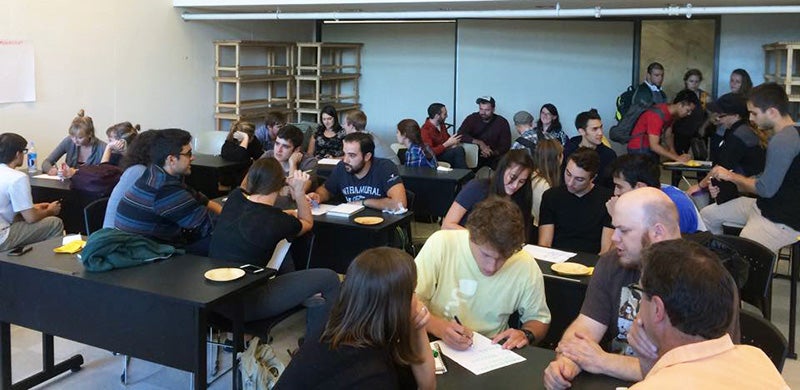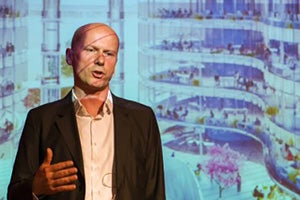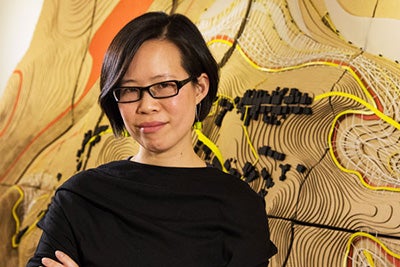The annual Holistic Options for Planet Earth Sustainability (HOPES) conference sponsored by the Ecological Design Center will be held on the UO campus April 9-11. This is the 21st year of the student-run conference, an opportunity for students, visiting scholars, and faculty and community members to discuss the relationship between ecology and design and how this connection can produce sustainable buildings.

Above: Students work together and across disciplines during a workshop at the HOPES 20 in 2014.
This year’s theme, Catalyst: 21st Century Systems, will be addressed in panels, keynote speakers, professional showcases, and workshops. A student design competition for a “parklet” will also be part of this year’s HOPES conference.
“HOPES this year more than ever is hoping to drive the question of sustainability outside our little world of architecture and design and letting everyone know that they can have a role to play this year,” says Tom Moss, co-director of the conference. “We’re excited because the scope of how we look at these topics is changing for the better every day, and we want everyone to leave this conference optimistic toward a future we can all collaborate on.”
Keynote speakers include:
• Michael Pawlyn, author of Biomimicry in Architecture (Royal Institute of British Architects, 2011). Pawlyn worked with the firm Grimshaw for ten years, helping to reinvent horticultural architecture for the Eden Project, leading the design of the warm temperate and humid tropics biomes and subsequent phases. He also developed the Grimshaw environmental management system, resulting in the company becoming the first firm of European architects to achieve certification to ISO14001. In 2007 Pawlyn delivered a talk at Google’s annual Zeitgeist conference and, in 2011, became one of only a small handful of architects to have a talk posted on TED.com; his TED talk has garnered more than 1.2 million viewers and is available in thirty-two languages. He is founder and director of Exploration Architecture Ltd. Pawlyn will be joining HOPES through video link.
• Carlo Ratti, an architect and engineer who practices in Italy and directs the SENSEable City Lab at the Massachusetts Institute of Technology. Ratti’s research attempts to understand the construction of the city through extensive data analysis. He has coauthored more than 200 publications and holds several patents. Ratti’s Digital Water Pavilion at the 2008 World Expo was hailed by Time as one of the Best Inventions of the Year. He has been included in Esquire’s Best and Brightest list, in Blueprint magazine’s 25 People Who Will Change the World of Design, and in Forbes People You Need to Know in 2011. Ratti was a presenter at TED 2011.
• Dorothy Tang, a landscape architecture professor at Hong Kong University also works in the field of biomimicry. Her research investigates the role of landscape strategies at the intersection of everyday operations and large-scale systems by exploring the relationships between productive landscapes, infrastructure, and ecological systems through a cultural lens. Her current research investigates landscape change due to production, infrastructure development, resource extraction, and urbanization at multiple scales. She is particularly interested in the rehabilitation of environmentally degraded landscapes due to mining, infrastructural systems in informal settlements or slums, and the relationship between urbanization and water resources.



Above left: At TEDSalon in London in 2010, Michael Pawlyn describes three habits of nature that could transform architecture and society: radical resource efficiency, closed loops, and drawing energy from the sun. Above middle: Carlo Ratti’s Digital Water Pavilion at the 2008 World Expo was hailed by Time as one of the Best Inventions of the Year. Ratti has been included in Esquire’s Best and Brightest list and in Blueprint magazine’s 25 People Who Will Change the World of Design. Above right: Dorothy Tang is particularly interested in the rehabilitation of environmentally degraded landscapes due to mining, infrastructural systems in informal settlements or slums, and the relationship between urbanization and water resources.
Other speakers and panelists include Karen Allen and Andrew Heumann, who will be talking about biomimicry and technological systems, respectively.
Panel discussion and workshops will cover topics including the future of transportation networks within broad city systems and the future of systems within design. Two additional panels will be moderated by outside groups: The topic area for KTISMAjournal will be the interaction of buildings with humans’ senses; while the topic area for STAnDD (Supporting The Advancement of Diversity in Design), is how diversity can impact the workplace.
A student design competition for a “parklet” is also part of HOPES 21. “A parklet is a temporary structure placed in the confines of a parking space that serves as an extension of the sidewalk and provides an additional space for people to gather, often with seating and plantings,” says architecture undergraduate student Meg Verplanck, an AIAS (American Institute of Architecture Students) board member. “The challenge is to design a parklet that engages the public and calls attention to the theme of the conference while providing a new space for people to gather and enjoy.”
The parklet must be designed for disassembly and follow safety guidelines. The chosen site is the parking space directly in front of the entrance to Townshend's Tea in Eugene (41 E. Broadway). This spot was chosen “because it is located in the heart of downtown and therefore will get maximum use and enjoyment,” Verplanck says. The parklet will be installed for one week beginning May 1 at Townshend’s, and be displayed at UO the week before and after.
A video featuring A&AA Acting Dean Brook Muller discusses the history of HOPES.
The HOPES 21 blog, Facebook page and Twitter page provide further information.

Above: Student members of the Ecological Design Center staff a table recently to help get the word out about this year’s HOPES conference.
